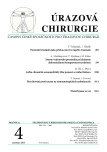Thoracic trauma as cause of the death in blunt injuries
Authors:
František Vyhnánek 1; Jiří Hladík 2
Authors‘ workplace:
Traumatologické centrum Chirurgická klinika, 2Ústav soudního lékařství FNKV a 3. LF UK Praha
1
Published in:
Úraz chir. 21., 2013, č.4
Overview
AIM:
Aim of study was on the basis of the analysis dead victims with blunt trauma evaluated the role of thorax trauma as cause of mortality.
METHODOLOGY:
In this study were analysed dead polytrauma patients with blunt trauma in period 2010–2012. Were chosen group of 210 patients. Thorax trauma were found in 178 (85 %) of victims.We analysed cause of death, mechanism of injury and number of intrathoracic injuried complications of dead victims.
RESULTS:
From all victims were 139 (66 %) after road traffic accidents, 65 (31 %) falls accounted 65 (31 %) and 6 (3 %) with working trauma. Thoracic trauma directly accouts 101 (48 %) of the deaths due to trauma. Thoracic trauma is a contributing factor to others 78 (37 %) of death in patients with blunt trauma (mostly with serious craniocerebral injuries). As primary cause of mortality was bleeding from injuries of lung (laceration and contusion) in 93 patients, heart (rupture and contusion) in 72, thoracic aorta (rupture) in 47 victims and injuries of others large intrathoracic vessels were in 17 dead. In victims with thoracic trauma as contributing factor of death were laceration or contusion of lung in 63 cases, contusion of heart in 14 patients with serious injuries of chest wall (flail chest, sternal fracture).
DISCUSSION:
Immediate mortality in polytrauma patients was significantly increasing with serious thoracic injuries. Same one in the place of accident and in early postinjuried period after admission in the hospital. Serious thoracic trauma was presented as second most frequent cause of mortality (35 %). Futher as one from others causes of the injuried death (35 %). It corresponded with our result of study, where serious thoracic trauma is besides craniocerebral injuries most frequent cause of mortality.
CONCLUSIONS:
Serious blunt thorax trauma is frequent cause of immediate and early death.
Keywords:
blunt thoracic trauma, cause of the death.
Sources
1. CAMERON, P., DZIUKAS, L., HADJ, A. et al. Pattern on injury from major trauma in Victoria. Aust N Z J Surg. 1995, 65, 848–852.
2. DE MESTRAL, C., DUECK, A., SHARMA, SS. et al. Evolution of the incidence, management, and mortality of blunt thoracic aortic injury: a population-based analysis. J Am Coll Surg. 2013, 216, 1110–1115.
3. EMIRCAN, S., ÖZGÜC, H., AKKÖSE AS. et al . Factors affecting mortality in patients with thorax trauma. Ulus Travma Acil Cerrahi Derg. 2011, 17, 329–333.
4. ESTRERA, AL., MILLER, CC., GUAJARDO-SALINAS, G. et al. Update on blunt thoracic aortic injury: fifthen-year single-institution experience. J Thorac Cardiovasc Surg. 2013, 145, 154–158.
5. EVANS, JA., VAN WESSEM KJP., McDOUGALL, D. et al. Epidemiology of traumatic deaths: Comprehensive population – based assessment. World J Surg. 2010, 34, 158–163.
6. KAČER , J. Traumata hrudníku v podmínkách okresní nemocnice. Úraz chir. 2012, 20, 49–54.
7. KLEBER,C., GIESECKE, MT., TSOKOS, M. et al. Overall distribution of trauma-related deaths in Berlin 2010: advancement or stagnation of German trauma management? World J Surg. 2012, 36, 2125–2130.
8. LIU, Y., DU, DY., HU, X. et al. Prevalence and mortality of severe chest trauma in Three Gorges Area of China. Zhongguo Yi Xue Ke Xue Yuan Bao. 2012, 34, 567–572.
9. ŠAFRÁNEK, V., ŠPIDLEN, V., KLEČKA, J. et al. Torakotomie pro hrudní trauma. Úraz chir. 2005, 13, 1–4.
10. VEYSI, TV., NIKOLAOU, VS., PALIOBEIS, CH. et al. Prevalence of chest trauma, associated injuries and mortality: a level I trauma centre experience. Int Orthop. 2009; 33, 1425–1433.
11. XAIAN-KAI, H., YU-JUN, Z., LIAN-YANG, Z. Damage control surgery for severe thoracic and abdominal injuires. Chin J Traumatol. 2007, 10, 279–283.
Labels
Surgery Traumatology Trauma surgeryArticle was published in
Trauma Surgery

2013 Issue 4
- Metamizole vs. Tramadol in Postoperative Analgesia
- Metamizole at a Glance and in Practice – Effective Non-Opioid Analgesic for All Ages
- Possibilities of Using Metamizole in the Treatment of Acute Primary Headaches
- Current Insights into the Antispasmodic and Analgesic Effects of Metamizole on the Gastrointestinal Tract
- Spasmolytic Effect of Metamizole
Most read in this issue
- Metabolic and biochemical changes in acute abdominal compartment syndrome
- Revaccination against tetanus at traumatology outpatient clinic
- Thoracic trauma as cause of the death in blunt injuries
- Treatment of chronic tibial osteomyelitis with external fixator
